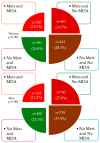Relationship between the Mediterranean Diet and Metabolic Syndrome and Each of the Components That Form It in Caucasian Subjects: A Cross-Sectional Trial
- PMID: 38931300
- PMCID: PMC11207079
- DOI: 10.3390/nu16121948
Relationship between the Mediterranean Diet and Metabolic Syndrome and Each of the Components That Form It in Caucasian Subjects: A Cross-Sectional Trial
Abstract
The main objective of this work is to investigate the relationship between the Mediterranean diet (MD) and metabolic syndrome (MetS) and its components in Caucasian subjects between 35 and 74 years. The secondary objective is to analyze sex differences.
Methods: A cross-sectional trial. This study utilized data from the EVA, MARK, and EVIDENT studies, and a total of 3417 subjects with a mean age ± SD of 60.14 ± 9.14 years (57% men) were included. We followed the five criteria established in the National Cholesterol Education Program III to define MetS. The MD was assessed with the 14-item Mediterranean diet adherence screener (MEDAS) used in the PREDIMED study. Good adherence was considered when the MD value was higher than the median value.
Results: The mean ± SD value of the MEDAS questionnaire was 5.83 ± 2.04 (men 5.66 ± 2.06 and women 6.04 ± 1.99; p < 0.001). Adherence to the MD was observed by 38.6% (34.3% men and 40.3% women; p < 0.001). MetS was observed in 41.6% (39.0% men and 45.2% women; p < 0.001). In the multiple regression analysis, after adjusting for possible confounders, the mean MD value showed a negative association with the number of MetS components per subject (β = -0.336), and with the different components of MetS: systolic blood pressure (β = -0.011), diastolic blood pressure (β = -0.029), glycemia (β = -0.009), triglycerides (β = -0.004), and waist circumference (β = -0.026), except with the HDL-cholesterol value which showed a positive association (β = 0.021); p < 0.001 in all cases. In the logistic regression analysis performed, we found that an increase in MD adherence was associated with a decrease in the probability of MetS (OR = 0.56) and its components: blood pressure levels ≥ 130/85 mmHg (OR = 0.63), fasting plasma glucose ≥ 100 mg/dL (OR = 0.62), triglyceride levels ≥ 150 mg/dL (OR = 0.65), waist circumference levels ≥ 88 cm in women and ≥102 cm in men (OR = 0.74), and increased high-density lipoprotein cholesterol < 40 mg/dL in men and <50 mg/dL in women (OR = 1.70); p < 0.001 in all cases. The results by sex were similar, both in multiple regression and logistic regression.
Conclusions: The results found in our work indicate that the greater the adherence to the MD, the lower the probability of presenting MetS. This result is repeated in the study by sex. More studies are needed to clarify that these results can be extended to the rest of the Mediterranean countries, and to other countries outside the Mediterranean basin.
Keywords: Caucasian subjects; Mediterranean diet; cross-sectional trial; metabolic syndrome.
Conflict of interest statement
The authors declare no conflicts of interest.
Figures




References
-
- Trichopoulou A., Martinez-Gonzalez M.A., Tong T.Y., Forouhi N.G., Khandelwal S., Prabhakaran D., Mozaffarian D., de Lorgeril M. Definitions and potential health benefits of the Mediterranean diet: Views from experts around the world. BMC Med. 2014;12:112. doi: 10.1186/1741-7015-12-112. - DOI - PMC - PubMed
MeSH terms
Substances
LinkOut - more resources
Full Text Sources
Medical

